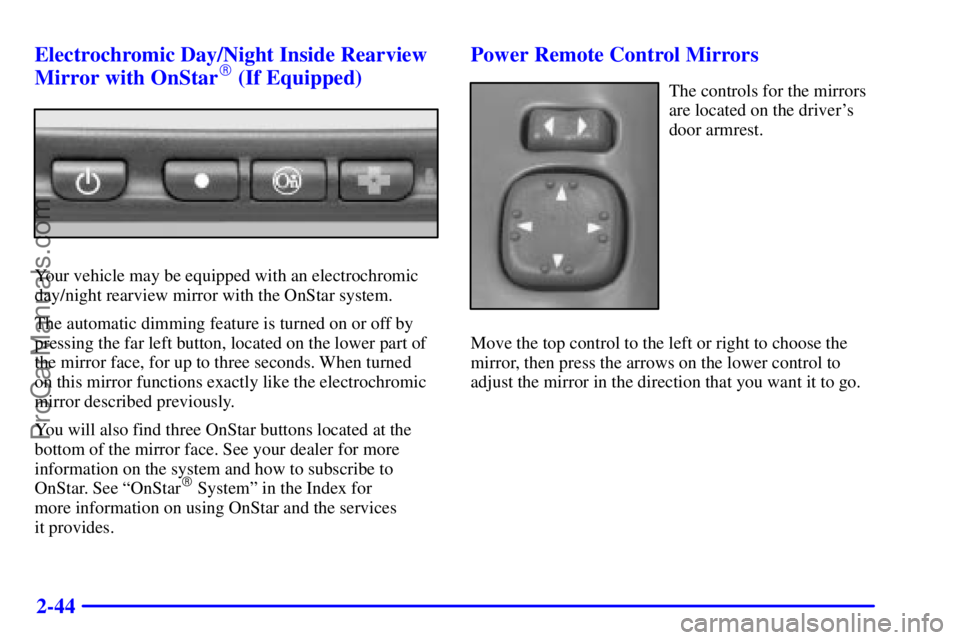Page 4 of 371
Table of Contents
Windows
Keys and Door Locks
Remote Keyless Entry System
Liftgate
Automatic Transmission
All-Wheel Drive
Parking Brake
Tilt Wheel
Turn Signal/Multifunction Lever
Windshield WipersCruise Control
Exterior and Interior Lamps
Mirrors
Storage Compartments
Luggage Carrier
Accessory Power Outlets
OnStar® System (If Equipped)
Sunroof (If Equipped)
HomeLink® Transmitter
Instrument Panel, Warning Lights and Gages Seats and Seat Controls
Safety BeltsAir Bag Systems
Restraint Systems for Children
Section
1
Section
2
Seats and Restraint Systems
Features and Controls
ii
ProCarManuals.com
Page 66 of 371

2-
2-1
Section 2 Features and Controls
Here you can learn about the many standard and optional features on your vehicle, and information on starting,
shifting and braking. Also explained are the instrument panel and the warning systems that tell you if everything is
working properly
-- and what to do if you have a problem.
2
-2 Windows
2
-4 Keys
2
-6 Door Locks
2
-10 Keyless Entry System
2
-13 Liftgate/Liftglass
2
-14 Theft
2
-16 Content Theft-Deterrent
2
-17 Passlock�
2-18 New Vehicle ªBreak-Inº
2
-18 Ignition Positions
2
-20 Starting Your Engine
2
-21 Engine Coolant Heater (If Equipped)
2
-22 Automatic Transmission Operation
2
-25 Parking Brake
2
-26 Shifting Into PARK (P)
2
-28 Shifting Out of PARK (P)
2
-29 Parking Over Things That Burn
2
-29 Engine Exhaust
2
-30 Running Your Engine While You're Parked2
-31 Locking Rear Axle
2
-31 All-Wheel Drive
2
-31 Horn
2
-31 Tilt Wheel
2
-32 Turn Signal/Multifunction Lever
2
-38 Exterior Lamps
2
-41 Interior Lamps
2
-43 Mirrors
2
-46 Storage Compartments
2
-54 Ashtrays and Cigarette Lighter
2
-55 Accessory Power Outlets
2
-55 OnStar� System (If Equipped)
2
-59 Sunroof (If Equipped)
2
-60 HomeLink� Transmitter
2
-64 The Instrument Panel--Your
Information System
2
-65 Instrument Panel Cluster
2
-67 Warning Lights, Gages and Indicators
ProCarManuals.com
Page 109 of 371

2-44 Electrochromic Day/Night Inside Rearview
Mirror with OnStar
� (If Equipped)
Your vehicle may be equipped with an electrochromic
day/night rearview mirror with the OnStar system.
The automatic dimming feature is turned on or off by
pressing the far left button, located on the lower part of
the mirror face, for up to three seconds. When turned
on this mirror functions exactly like the electrochromic
mirror described previously.
You will also find three OnStar buttons located at the
bottom of the mirror face. See your dealer for more
information on the system and how to subscribe to
OnStar. See ªOnStar
� Systemº in the Index for
more information on using OnStar and the services
it provides.
Power Remote Control Mirrors
The controls for the mirrors
are located on the driver's
door armrest.
Move the top control to the left or right to choose the
mirror, then press the arrows on the lower control to
adjust the mirror in the direction that you want it to go.
ProCarManuals.com
Page 129 of 371
2-64
The Instrument Panel--Your Information System
The main components of your instrument panel are the following:
A. Air Vents
B. Turn Signal/Multifunction Lever
C. Instrument Panel Cluster
D. Lamp Controls
E. Fog Lamps
F. Brake ReleaseG. Audio Steering Wheel Controls
(If Equipped)
H. Rear Window Washer/Wiper
I. Rear Liftgate Glass Release
J. Ashtray
K. Comfort ControlsL. Rear Window and
Mirror Defogger
M. Accessory Power Outlets
N. Audio System
O. Glove Box
ProCarManuals.com
Page 214 of 371

4-48 Driving with a Trailer
CAUTION:
If you have a rear-most window open and you
pull a trailer with your vehicle, carbon monoxide
(CO) could come into your vehicle. You can't
see or smell CO. It can cause unconsciousness
or death. See ªEngine Exhaustº in the Index.
To maximize your safety when towing a trailer:
�Have your exhaust system inspected for
leaks, and make necessary repairs before
starting on your trip.
�Keep the rear
-most windows closed.
�If exhaust does come into your vehicle
through a window in the rear or another
opening, drive with your front, main
heating or cooling system on and with
the fan on any speed. This will bring fresh,
outside air into your vehicle. Do not use
RECIRCULATION because it only
recirculates the air inside your vehicle.
See ªComfort Controlsº in the Index.
Towing a trailer requires a certain amount of experience.
Before setting out for the open road, you'll want to get
to know your rig. Acquaint yourself with the feel of
handling and braking with the added weight of the
trailer. And always keep in mind that the vehicle you
are driving is now a good deal longer and not nearly as
responsive as your vehicle is by itself.
Before you start, check the trailer hitch and platform
(and attachments), safety chains, electrical connector,
lamps, tires and mirror adjustment. If the trailer has
electric brakes, start your vehicle and trailer moving
and then apply the trailer brake controller by hand to be
sure the brakes are working. This lets you check your
electrical connection at the same time.
During your trip, check occasionally to be sure that the
load is secure, and that the lamps and any trailer brakes
are still working.
Following Distance
Stay at least twice as far behind the vehicle ahead as
you would when driving your vehicle without a trailer.
This can help you avoid situations that require heavy
braking and sudden turns.
ProCarManuals.com